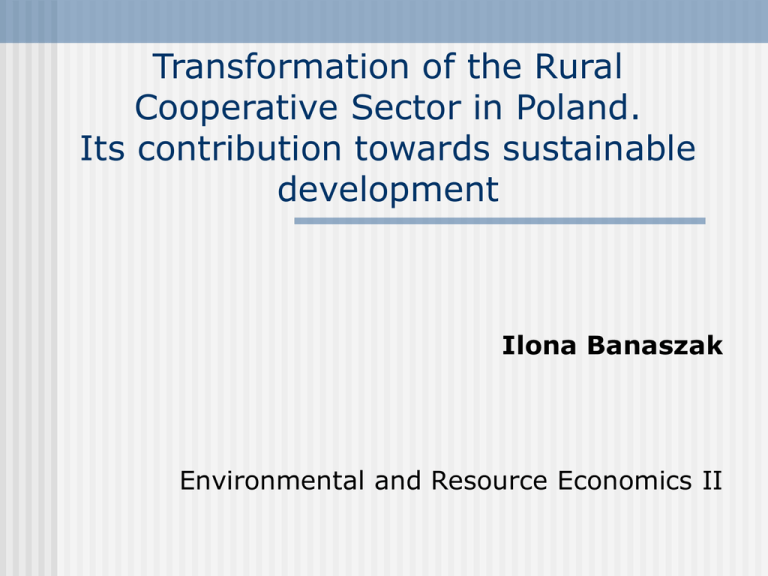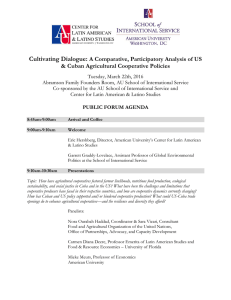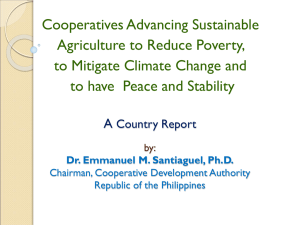Transformation of the Rural Cooperative Sector in Poland. Its contribution towards sustainable development
advertisement

Transformation of the Rural Cooperative Sector in Poland. Its contribution towards sustainable development Ilona Banaszak Environmental and Resource Economics II Purpose of the presentation To discuss: History of rural cooperatives in Poland. Influence of ideology on economic and social life, how changing ideology has been influening attitudes towards cooperatives; To which extend the cooperative movement may help to achieve the path of sustainable development by polish rural areas; 2 Theoretical background (1): Sustainable development “Sustainable development is the management and conservation of the natural resource base, and the orientation of technological and institutional change in such a manner as to ensure the attainment and continued satisfaction of human needs for present and future generations. Such sustainable development (in the agriculture, forestry and fishery sectors) conserves land, preserves water, plant and animal genetic resources, in environmentally non-degrading, technically appropriate, economically viable and socially acceptable” (FAO 1994) 3 Theoretical background (2): 6 dimensions of sustainability in agriculture and horticulture Ethic dimension; Ecological dimension; Global dimension; Retinity dimension; Economic dimension: securing commercial viability of farms, improving on-farm employment opportunities, being responsible for food security and food quality, contributing to gross national product; Social dimension: developing the rural social capital, stimulating participation of the rural population, improving the living and working conditions of the rural population, developing social infrastructure and social security services (Hagedorn 2004). 4 Theoretical background (3): Social capital Mutual trust and how effectively people work together, e.g. transaction costs are lowered because informal self-enforcement of contracts can take place without third party enforcement; since agents can save monitoring and transaction costs, social capital may also be regarded as a new production factor alongside the traditional ones of human and physical capital (Coleman 1988); Social capital can be measured by: (1) membership in voluntary organisations (e.g. a cooperative), (2) trust, (3) civic participation (Paldam 2000, Chloupkova et al. 2003). 5 Theoretical background (4): Cooperatives Cooperative movement: aiming in achieving certain economic goals by less powerful (/poor) economic groups, based on cooperation and reciprocal aid; Cooperation must be conscious, voluntary and based mainly on resources of the associated – self-aid and self organisation principles (Brzozowski 1998); Cooperative – main form of the cooperative movement; Cooperative: autonomous union of people who voluntary join together in order to fulfil certain economic, cultural and social needs by establishment of a common and democratically govern enterprise (ibid.); 6 Cooperatives and sustainable development Cooperative movement aims in improving economic and social situation of underprivileged social groups; Participation in cooperatives strengths social capital; Cooperatives may contribute towards more rational using of means of production (e.g. shared machinery) and more rational production methods (e.g. diffusion of knowledge), creation of on- and off-farm employment, development of the whole local community; 7 Rural cooperatives in Poland: before the 1st world war 1816: 1st coop, established by a nobleman and politician S. Staszic for peasants: Hrubieszów Agricultural Association of Mutual Help in Misfortune; on a part of land offered by Staszic joint farming; a fund from income and taxes spent on help for members, schools, scholarships; In the part under Prussia and Austrian regime from 1860s: agricultural and trade, dairy, savings and loans coops; mainly to support Polish peasants oppressed by the authorities. 8 Rural cooperatives in Poland: Between the Wars: 1918 - 1939 Cooperative movement propagated by F. Stefczyk; he aimed in gaining by peasants profits taken by middlemen, industrialisation of agricultural production, higher profitability of farms; The most frequent: saving-credit cooperatives – simple forms, acting within parishes and based on trust between creditors and borrowers; Other forms: agricultural-trade coops (rather big, associating rich peasants); dairy coops (organising purchase of milk, eggs, also simple processing of milk and butter production, exporting to the Western Europe); consumer coops (usually based on one shop within a village providing basic products); - Retreat from 1935-1936 as a result of the international crisis; In 1937 11% of the inhabitants of Poland (including also minorities) were members of cooperatives; 9 Number of cooperatives and their members in 1937 Coop’s type No. of coops No. of members (thous.) Loan 5 517 1 515 Dairy 1 408 543 Consumer 1 808 366 Agricultural-consumer 2 973 353 Agricultural-trade 410 22 Housing 252 58 Other 496 76 Total 12 860 2 933 10 Rural cooperatives in Poland: After the 2nd World War First coops voluntary formed to govern and farm former German holdings (in 1948: 91 such coops with 2 300 member); Reactivated coops connected with non-communistic part of the peasant movement or politically neutral; From Dec. 1944 efforts of the authorities to subordinate the cooperative movement; 11 Rural cooperatives in Poland: After 1948 – communism Abolition of most of voluntary, not subordinated to the state’s control cooperatives (e.g. in dairy, gardening and credits); Political, administration and economic pressure on farmers to joint cooperatives; Cooperatives subjected to the state: introduction of control mechanisms, centralised and bureaucratised planning; Due to strong resistance of farmers and not sufficient financial incentives in 1955 cooperatives associated only 10% of the agricultural land and 8% of peasant families; 12 Rural cooperatives in Poland: After 1956 – destalinisation In 1956 after the ‘destalinisation’ and neglecting Stalinist ideology, mass abandonment of cooperatives by peasants – 85% of cooperatives split, also these functioning well; As the result of the process of democratisation and decentralisation some local reactivation of dairy, gardening and saving-consumer cooperatives and rural cooperatives based on providing equipment for farmers – nevertheless still under the state’s control; 13 1960 - 1989 New forms of cooperation introduced, e.g. a collective farm associated with a few individual farms, in 70s around 200 such cooperatives, nevertheless, most of them collapsed till 1980; In 70s and 80s the state more and more intervened in cooperatives’ production and decision making; Number of cooperatives was slightly increasing, but no. of members decreasing (in 1985: 8 382 rural coops, 7 000 urban); 14 Polish rural cooperative movement 1988 Type Number Members Employees Significance Supply & marketing 1,912 3,531,500 434,570 Dairy coops Horticultural coops 323 140 1,199,400 372,600 112,793 55,519 Agricultural production coops Savings & credit 2,086 177,000 2,700 59% of marketing of agricultural products 95% of milk processed 50% of fruits and vegetable 2.8% of arable land 1,663 2,566,100 31,290 Agricultural circles 2,006 113,200 154,447 Total Source: ICA 1993 8,130 7,959,800 791,319 18.5% of population’s saving Important share in mechanization service 15 Rural cooperatives in Poland: After 1989 - transformation In 1989 the cooperative sector associated several millions of people, was rather good economically developed; controlled but in a privileged position (legal aid, better access to the means of production, financial support, etc.); Due to transformation the situation of the sector changed for the worse: in contradiction to the Constitution functioning of unions of cooperatives was abolished, their assets were sold below the value; subventions, funds and other aid was stopped; inspecting the cooperatives by the state stopped, cultural, training, publishing activities of cooperatives abolished; taxes even higher that for the private sector; opening the market for foreign agricultural and other goods; neglecting achievements of the cooperatives also neglecting economic and social benefits that may be achieved by cooperatives; - - 16 Cooperatives in 90s: - Share of cooperative sector decline dramatically: From 9.5% share in GDP in 1989 to 2.4% share in 1994; From 12.8% share in employment in 1989 to 4.8% in 1994 and to 3.5% in 1996; 17 Rural cooperatives in Poland: Presence: Come back of the idea of cooperatives, new form e.g. agricultural producer groups – promoted by the government; seen as a ‘chance’ for Polish agriculture; Till presence reluctance and aversion of farmers towards cooperatives. 18 Conclusions: Before the 2nd WW the cooperative organisations grew up bottom-up as local and regional peasants movement against economic threats from other social classes or foreign powers; They strengthened economic and social power of peasants; A substantial level of social capital on rural areas was achieved; These networks, social capital and trust destroyed by socialism – obligatory participation, state intervention, central planning; Nevertheless, the cooperative sector was present and active in some areas before 1989 (e.g. dairy, agriculture machinery); Transformation denied these achievements, annihilated the cooperative movement; Double disaster; Now: how to build a bridge between pre-socialism practise and presence? 19 Thank you!






